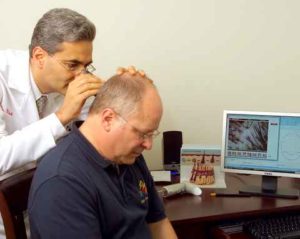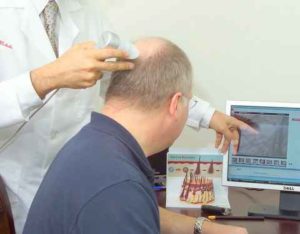HAIR LOSS EVALUATION
HAIR RESTORATION A NATURAL, PROVEN AND PERMANENT SOLUTION
The natural, proven and permanent solution to hair loss begins with a thorough consultation from a skilled hair restoration physician. At our medical centers a complete evaluation of your scalp is conducted; as well as a thorough microscopic hair assessment. This hair assessment is more commonly known as the miniaturization study,a critically important part of the proper diagnosis for every hair loss patient.
Obtaining personal family history of baldness is critical in making the proper diagnosis. This is includes information from both the maternal and paternal heritage of the patient. Your detailed history includes the time, speed and quality of hair loss. Consideration is given to any possible associative medical, physical or emotional factors.


Dr. Parsa Mohebi, medical director performs a miniaturization study – this is a key step in
hair loss evaluation to assess stablity of donor area and predict the progress of hair loss.
There are increased levels of evaluation when we diagnose hair loss in woman. The medical history can play a major factor in determining the best course of medical treatment for female hair loss. A female patient’s medical history may help us discover a treatable disorder that leads to the accelerated hair loss in women known as female pattern baldness (FPB.)
COMMON DISORDERS CAN CAUSE HAIR LOSS.
Iron deficiency, thyroid disorders, autoimmune diseases such as lupus and hormonal imbalances, such as increased male hormone or altered estrogen or progesterone levels can effect hair loss. There are some medications could cause hair loss in both men and women in which case a more detailed history of medication use would be obtained.
THE MINIATURIZATION STUDY
During the miniaturization study a recording of the hair caliber changes on a microscopic level is used to diagnose most common hair loss patterns. This microscopic evaluation is also used to predict future hair loss. The initial evaluation includes measurements of donor quality and scalp laxity. These two factors are key to patients who undergo hair transplant procedure.
An examination is important because it helps us to determine a person’s qualifications for hair transplantation and to estimate the number of grafts needed. The pattern of hair loss, especially whether it is focal or diffused, may help diagnose the type of baldness. Some of the less common types of hair loss such as alopecia areata present with very limited focal hair loss.
HAIR TRANSPLANT RESULTS
The appearance of your hair after hair transplant surgery is the single most important factor. These characteristics include: thicker hair vs. thinner one, wavy vs. straight and minimum contrast of hair with the skin. Less contrast means less visibility of the scalp and less appearance of baldness.